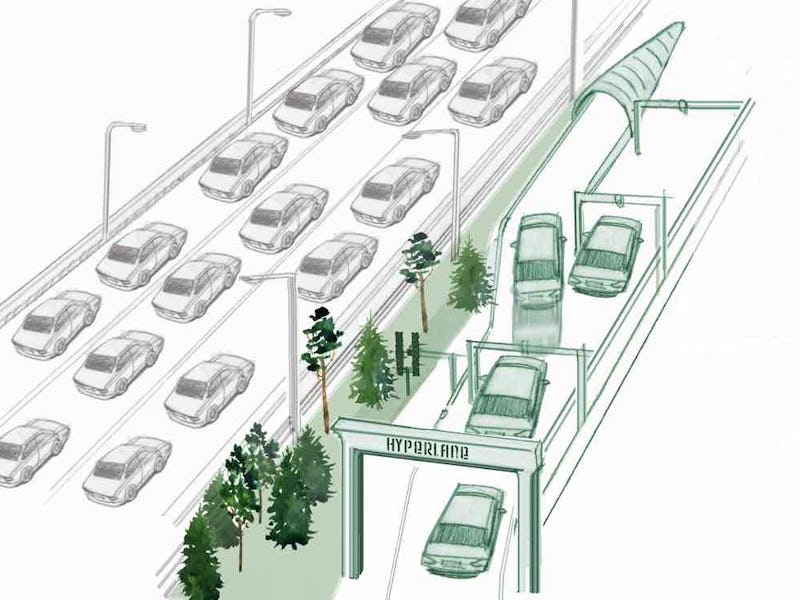Forget Hyperloop; Here's a Plan to Zip Down the 'Hyperlane'

For alleviating traffic woes in both isolated and jam-packed areas of the country, high speed rail sometimes seems like a useful solution to a desperate transportation solution. But it’s also really, really expensive. And more radical solutions like Hyperloop will cost even more. Fortunately, two grad students at the University of California at Berkeley, think they’ve found a cheaper fix that still gets people to their destination quickly enough. They call it (what else?) the Hyperlane.
“What we envision with Hyperlane is a more intelligent interstate,” Baiyu Chen, who developed the idea, told Inverse.
A rendering of Barrs and Chen's Hyperlane concept.
Right now, California is in the midst of constructing high speed rail connecting its two major hubs, San Francisco and Los Angeles. But the cost is coming in at, oh, $139 million per mile.
Chen and his colleague Anthony Barrs are proposing a Hyperlane that would give autonomous vehicles their own lane and allow the whole horde of cars to travel over 100 mph, all on existing roads. They imagine it’d all be controlled by a centralized computer system — and cost a comparatively cheap $12 million a mile.
Depending on the location, the Hyperlane could be set up in one of two ways. In open areas, it could be a highway of its own, built up from scratch. In denser areas that don’t have the space, however, an existing lane could be dedicated for autonomous cars and sensors could be added to the road.
Regardless of what methods individual cities take, the Hyperlane would work roughly the same wherever it was installed: An autonomous car would enter into a special high speed lane. There, the car would be essentially taken over by the Hyperlane’s computer and placed into a little slot would propel it forward, as fast as 120 miles per hour.
An Uber self-driving car in the wilds of San Francisco, California.
Chen says the Hyperlane would ease traffic by moving cars around pretty quickly, but also by relying on the computer to crunch the cars closer together. Because those vehicles would be controlled by a single 5G system, they’d be communicating with each other and able to move more or less in unison. Chen estimates the Hyperlane would ultimately have four times the capacity of a traditional highway.
The proposed system would ideally generate a substantial amount of revenue as well, through surge pricing. And it would encourage carpooling by allowing users of high-occupancy autonomous vehicles, like the autonomous bus Olli, to share the cost of the ride.
“We were inspired by high speed rail in Europe and Asia, which is reliable, fast, and accommodate a lot of people and relatively cheap,” Chen says. “So we wanted something like this, yet it’s applicable to America.”
Of course, not every American road is ripe for the Hyperlane. Autonomous cars aren’t exactly legal yet, and no one’s sure how legislation will adjust in the coming years. Moreover, while Chen thinks their idea would fit in well in the traffic-heavy, tech-loving Bay area, he knows many people distrust autonomous car technology entirely, potentially making Hyperlane a tough sell.
But Chen says that in places like California’s urban cores, where traffic is notoriously terrible, “Everyone is hoping there’s some kind of solution… so [Hyperlane] would definitely be a great option for them.”